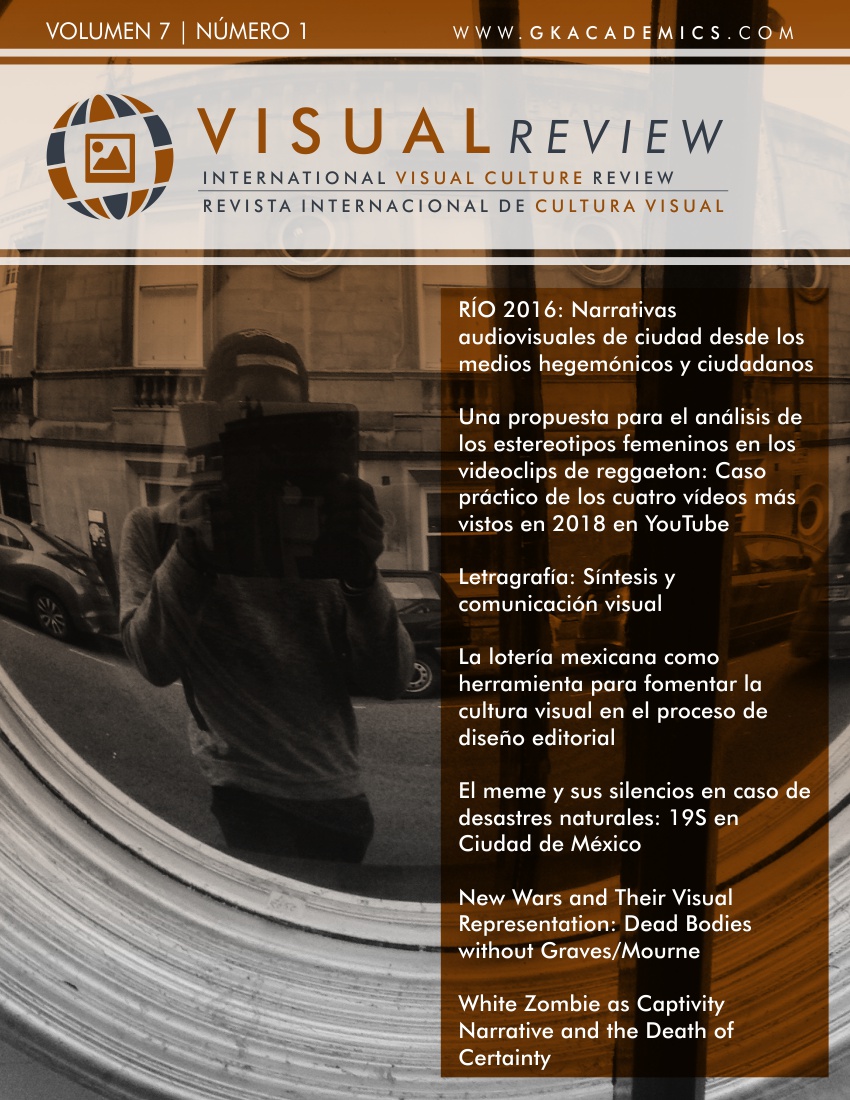New Wars and Their Visual Representation: Dead Bodies without Graves/Mourne
DOI:
https://doi.org/10.37467/gka-revvisual.v7.2598Palabras clave:
Power, New Wars, Dead Bodies, Representation, Visual Images, Middle East, ViolenceResumen
This paper seeks to understand why there has been an increase in photographic images exposing military violence or displaying bodies killed by military forces and how they can freely circulate in the public without being censored or kept hidden. In other words, it aims to analyze this particular issue as a symptom of the emergence of new wars and a new regime of their visual representation. Within this framework, it attempts to relate two kinds of literature that are namely the history of war and war photography with the bridge of theoretical discussions on the real, its photographic representation, power, and violence. Rather than systematic empirical analysis, the paper is based on a theoretical attempt which is reflected on some socio-political observations in the Middle East where there has been ongoing wars or new wars. The core discussion of the paper is supported by a brief analysis of some illustrative photographic images that are served through the social media under the circumstances of war for instance in Turkey between Turkish military troops and the Kurdish militants. The paper concludes that in line with the process of dissolution/transformation of the old nation-state formations and globalization, the mechanism and mode of power have also transformed to the extent that it resulted in the emergence of new wars. This is one dynamic that we need to recognize in relation to the above-mentioned question, the other is the impact of social media in not only delivering but also receiving war photographies. Today these changes have led the emergence of new machinery of power in which the old modern visual/photographic techniques of representing wars without human beings, torture, and violence through censorship began to be employed alongside medieval power techniques of a visual exhibition of tortures and violence.
Descargas
Estadísticas globales ℹ️
|
731
Visualizaciones
|
260
Descargas
|
|
991
Total
|
|
Citas
Alpkaya, Gökçen. (2016). Anayasa ve Yasalar Karşısında Ölü-Beden ve Ötekiler, Evrim C. İflazoğlu & A.Aslı Demir (der), Öteki Olarak Ölmek, Ankara: Dipnot Yayınları, 163- 172.
Balta, Evren. (2016). Ölü Bedenlerin Siyasal Yaşamları, Evrim C. İflazoğlu & A. Aslı Demir (der), Öteki Olarak Ölmek, Ankara: Dipnot Yayınları, 145-161.
Barthes, Roland. (1996). Camera Lucida: Fotoğraf Üzerine Düşünceler. Çev., Reha Akerçakaya. İstanbul: Altıkırkbeş Yayınları.
Berger, John. (1988). O Ana Adanmış, İsntabul: Metis Yayınları.
Berger, John. (2016). Bir Fotoğrafı Anlamak, çev, Beril Eyüboğlu, İstanbul: Metis Yayınları.
Boudrilard, Jean. (1995). Gulf War Did not Take Place, Bloomington and Indiana Polis: Indiana University Press.
Bozarslan, Hamit. (2014). Sunuş, G.Çeğin & İ. Şirin (der), Türkiye’de Siyasal Şiddetin boyutları içinde, İstanbul: İletişim Yayınları, 9-30.
Brown, W. (2010). Walled states, waning sovereignty. New York: Zone Books. DOI: https://doi.org/10.2307/j.ctv14gpj55
Burke, Peter. (2003). Afişten Heykele, Minyatürden Fotoğrafa Tarihin Görgü Tanıkları. (Original Name of the Book: Eyewitnessing The Uses of Images as Historical Evidence), Trans. By Zeynep Yelçe. İstanbul: Kitap Yayınevi.
Butler, Judith. (2009). Frames of War, London: Verso.
Butler, Judith. (2013). Kırılgan Hayat: Yasın ve Şiddetin Gücü. Çev.,Başak Ertür. İstanbul: Metis Yayınları.
Camphell, David. (2004). “Horrific Blindness: Image of Death in Contemporary Media.” Journal for Cultural Research. 8 (1): 55-74. DOI: https://doi.org/10.1080/1479758042000196971
Derrida, Jacques. (2002). “History of the Lie: Prolegomena”, Without Alibi in, (ed) Peggy Kamuf, Stanford University Press. DOI: https://doi.org/10.1515/9780804779975-005
Deutsche Welle. (2015). Who is the ‘Islamic State’? http://www.dw.com/en/who-is-the Islamic-state/a-18853223 [Access: 10.11.2016].
Fanon, Frantz. (2013). Yeryüzünün Lanetlileri, çev, Şen Süer, İstanbul: Versus Yayınları.
Foucault, Michel. (1977). Discipline and Punish, New York: Pantheon.
Foucault, Michel. (1980). "The Confession of the Flesh" in Power/Knowledge: Selected interviews and Other Writings 1972-1977 by Michel Foucault, C. Gordon (ed.), Brighton: Harvester Wheatsheaf.
Foucault, Michel. (2005). Özne ve İktidar. Çev.,Ergüden, I., & Akınhay, O., İstanbul: Ayrıntı Yayınları.
Foucault, Michel. (2013). Hapishanelerin Doğuşu, çev, Mehmet Ali Kılıçbay, Ankara: İmge Yayınları.
Grossberg, Lawrence. (1992). Dancing In Spite Of Myself: Essays on Popular Culture, Durham: Duke University Press. HDP. (2016). The Cize Report, April 17, Ankara.
Hobsbawn, Eric. (2013). Kısa 20. Yüzyıl Tarihi, çev, Yavuz Alogan, İstanbul: Everest Yayınları.
Jessop, B. and K. Bonnett, S. Bromley, T. Ling. (1989). Thatcherism: A Tale of Two Nations, London: Black Well.
Kaldor, Mary. (1999). New and Old Wars, Organized Violence in Global Era, Standford University Press: Standford.
Koyré, Alexander (1945) “The Political Function of the Modern Lie” (Contemporary Jewish Record), the American Jewish Committee New York N.W.
Mbenme, Achille. (2016). Nekro Siyaset, çev, Abdurrahman Aydın, Evrim C. İflazoğlu&A.Aslı Demir (der), Öteki
Olarak Ölmek, Ankara: Dipnot Yayınları, 223-270.
Özsoy, Hişyar (2012), Araf’ta Kalmak: Tarih Mezarla Başlar, http://politikart1.blogspot.nl/2012/05/arafta-kalmak-tarih-mezarda-baslar.html
Rabinow, Paul. (1991), The Foucault Reader, P. Rabinow (ed.), Harmondsworth: Penguin.
Rancier, Jaques (2006), Hatred of Democracy, London and New York: Verso.
Said, W. Edward (1979), Orientalism, Vintage Books Edition.
Schmidinger, Thomas. (2015). Suriye Kürdistan’ında Savaş ve Devrim: Rojava’dan Sesler, Analizler. Çev., Sevinç Altınçekiç. İstanbul: Yordam Yayınları.
Sheridan, Alan. (1994), Michel Foucault: The Will to Truth, London: Routledge.
Sontag, Susan. (2005). Başkalarının Acısına Bakmak. Çev., Osman Akınhay. İstanbul: Agora Yayınları.
Sontag, Susan. (2008). Fotoğraf Üzerine. Çev.,Osman Akınhay. İstanbul: Agora Yayınları.
Taştekin, Fetim. (2016). Rojava, Kürtlerin Zamanı, İstanbul: İletişim Yayınları.
Turner, Bryan, S. (1991). "The Discourse of Diet", in The Body: Social Process and Cultural Theory, M. Featherstone, M. Hepworth and B. Turner (eds.), Sage. DOI: https://doi.org/10.4135/9781446280546.n5
Vigarello, Georges. (1995). "The Life of the Body in Discipline and Punish", Sociology of Sport Journal, 12, pp. (158-163) DOI: https://doi.org/10.1123/ssj.12.2.158
Descargas
Publicado
Cómo citar
Número
Sección
Licencia
Los autores/as que publiquen en esta revista aceptan las siguientes condiciones:
- Los autores/as conservan los derechos de autor.
- Los autores/as ceden a la revista el derecho de la primera publicación. La revista también posee los derechos de edición.
- Todos los contenidos publicados se regulan mediante una Licencia Atribución/Reconocimiento-SinDerivados 4.0 Internacional. Acceda a la versión informativa y texto legal de la licencia. En virtud de ello, se permite a terceros utilizar lo publicado siempre que mencionen la autoría del trabajo y a la primera publicación en esta revista. Si transforma el material, no podrá distribuir el trabajo modificado.
- Los autores/as pueden realizar otros acuerdos contractuales independientes y adicionales para la distribución no exclusiva de la versión del artículo publicado en esta revista (p. ej., incluirlo en un repositorio institucional o publicarlo en un libro) siempre que indiquen claramente que el trabajo se publicó por primera vez en esta revista.
- Se permite y recomienda a los autores/as a publicar su trabajo en Internet (por ejemplo en páginas institucionales o personales), una vez publicado en la revista y citando a la misma ya que puede conducir a intercambios productivos y a una mayor y más rápida difusión del trabajo publicado (vea The Effect of Open Access).













